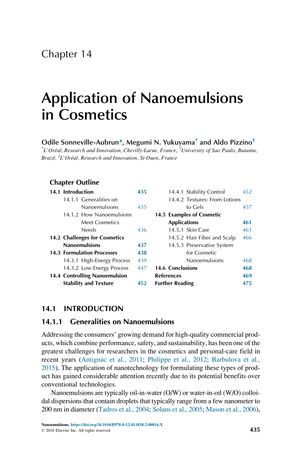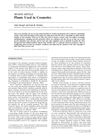Application of Nanoemulsions in Cosmetics
January 2018
in “Elsevier eBooks”

TLDR Nanoemulsions improve stability and delivery of active ingredients in cosmetics for skin and hair care.
The document from 2018 explores the use of nanoemulsions in the cosmetic industry, particularly for skin and hair care products. Nanoemulsions are small droplet colloidal dispersions that offer benefits such as improved stability, controlled particle sizes, and enhanced penetration of active ingredients. The document discusses various methods for creating stable nanoemulsions, including high-pressure homogenization and low-energy techniques like the phase inversion temperature (PIT) method. It also addresses challenges such as ensuring safety and compatibility with other ingredients. For skin care, nanoemulsions can deliver lipids like ceramides to improve skin hydration and elasticity, as demonstrated in an in vivo study on 14 healthy female volunteers. In hair care, nanoemulsions facilitate better silicon-oil deposition on hair, as shown in a study by Hu et al. (2012), and can target hair follicles for hair loss treatment, as seen in research by Aljuffali et al. (2014). The document also mentions the development of a new preservative system by Fang et al. (2016) that leverages nanoemulsion properties. Overall, the cosmetic industry is actively researching and patenting nanoemulsion-based products for their advantageous properties.
View this study on doi.org →
Cited in this study

research Squarticles as a Lipid Nanocarrier for Delivering Diphencyprone and Minoxidil to Hair Follicles and Human Dermal Papilla Cells
Squarticles effectively deliver hair growth drugs to follicles and dermal papilla cells.
research Human hair: A unique physicochemical composite
Related

research Plants used in cosmetics
Natural products in cosmetics are beneficial for skin and hair care with low toxicity.
research The Value of Hair Cosmetics and Pharmaceuticals
Hair care products are important for appearance and self-esteem, and their benefits and risks should be accurately communicated by experts.